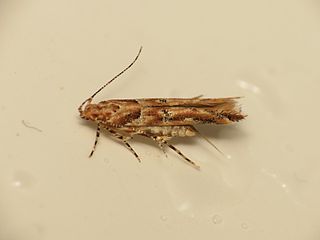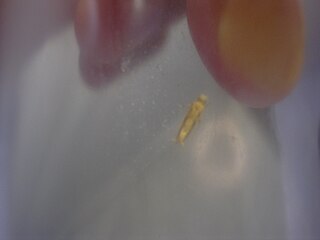Chrysophyllis is a genus of the grass moth family (Crambidae). It is monotypic, containing the single species Chrysophyllis lucivaga. This moth is very little known, having only been recorded once, before 1935. It belongs to the large grass moth subfamily Spilomelinae; at the time of its description, these were still included in subfamily Pyraustinae and the entire Crambidae was then merged with the snout moths. While its exact relationships are undetermined, it is believed to be a close relative of Talanga. Like these, the male genitalia of C. lucivaga feature a remarkably elongated aedeagus shaped like a bullwhip.
Marasmianympha is a genus of moths of the grass moth family (Crambidae) described by Eugene G. Munroe in 1991. Its single species, Marasmianympha eupselias, was described by Edward Meyrick in 1929. Among the grass moths, it belongs to subfamily Spilomelinae. It is endemic to the Marquesas Islands of Polynesia, where it has been recorded on Fatu Hiva, Hiva Oa and Tahuata, but is suspected to occur on other islands as well. The holotype specimen is in the Natural History Museum, London.
Clarkeophlebia is an enigmatic and almost-unknown gelechioid moth genus. It contains a single species, Clarkeophlebia argentea, and is apparently endemic to Fatu Hiva in the Marquesas Islands of Polynesia. It was originally described as Acanthophlebia, but this name had earlier been given to a genus of prong-gilled mayflies.

Anatrachyntis is a genus of moths in the family Cosmopterigidae. Some authors include it in Pyroderces.
Herlinda is a genus of cosmet moths. These moths were only discovered in 1968 and the genus was not described until 1986; its affiliations within the family are presently unknown. This genus, as far as is known, is endemic to the Marquesas Islands of Polynesia, with each species confined to a single island.

Pyroderces is a genus of cosmet moths. It belongs to subfamily Cosmopteriginae. Some authors include Anatrachyntis here.

Pyralis pictalis, the painted meal moth or poplar pyralis, is a snout moth. It is closely related to the family's type species the meal moth and consequently belongs to the tribe Pyralini of the snout moth subfamily Pyralinae. Its native range is tropical Asia to East Asia and to Wallacea and adjacent regions, but it has been quite widely distributed by humans. The term "Poplar" in its common name does not refer to the trees, but to Poplar, London, where the type specimen – from such an introduction – was caught. It was called scarce meal moth in the original description, which is only correct for the fringes of its range however.
Trissodoris honorariella, the pandanus leaf perforator or pandanus hole-cutter moth, is a small cosmet moth species. It belongs to subfamily Cosmopteriginae and is the type species of the genus Trissodoris. Baron Thomas Walsingham in 1907 had specimens from both ends of the species' range – New Guinea and Pitcairn Island – which he described as separate species Stagmatophora honorariella and S. quadrifasciata in the same work. But his mistake was soon recognized, and when Edward Meyrick established the genus Trissodoris in 1914, he chose the former name to be valid.
Anatrachyntis rileyi, the pink cornworm, pink bud moth or pink scavenger, is a species of moth of the family Cosmopterigidae, the cosmet moths. It was first described by Lord Walsingham in 1882 from the southern United States, but it is probably an introduction to North America. It is found in much of the warm or tropical areas of the world, including northern Australia, the Galápagos Islands, Hawaii, the Antilles, South America and Mauritius.

Anatrachyntis badia, the Florida pink scavenger, is a species of moth of the family Cosmopterigidae. It was first described by Ronald W. Hodges in 1962. It is found in the southern United States from Florida to California and as far north as Maryland. It is an introduced species in Europe, where it has been recorded infrequently from Italy, Greece, Spain, Malta, the United Kingdom, Poland and Turkey through accidental importation in pomegranates. In Germany, it was first recorded in 2011 in a tropical greenhouse in a zoological garden, where caterpillars where found living in colonies of the mealybug Palmicultor lumpurensis on bamboo. It has also been recorded from Hawaii.
Phereoeca allutella, the household case-bearing moth, belongs to the subfamily Tineinae of the fungus moth family (Tineidae). It was first described by Hans Rebel in 1892. It is an occasional pest of furs, flannel and similar materials, and has been inadvertently introduced to many places it is not originally native to.
Erechthias flavistriata, the sugarcane bud moth, is a moth of the family Tineidae. It was described by Lord Walsingham in 1907 from Hawaii, but is probably an introduced species. It is found in large parts of the Pacific Rim including the Marquesas, Rapa Iti, Fiji, the New Hebrides, the Kermadec Islands, the Solomons, Java and Malaya. It has been spread widely by man and probably has travelled to many islands throughout much of the Pacific in the canoes of the native peoples.

Erechthias minuscula, the erechthias clothes moth, is a moth of the family Tineidae. It was first described by Lord Walsingham in 1897. It is widespread and has been recorded from Africa, Sri Lanka, Java, Australia, the Caroline Islands, Fiji, Samoa, the Marquesas, the West Indies, Hawaii and Florida.

Erechthias simulans is a species of fungus moth. It is here considered to belong to the somewhat controversial type genus of its subfamily Erechthiinae, though even fairly recently some authors have proposed to retain other genera such as Decadarchis separate from Erechthias. Decadarchis, with E. simulans as type species, would in fact contain this moth and its closest relatives, regardless whether it is recognized as full genus or as subgenus. These relatives are generally held to be a group of mainly Polynesian species. E. simulans has also been mistaken for a species of the closely related genus Comodica; while the delimitation of this versus Erechthias/Decadarchis is not universally agreed upon, E. simulans is not included in Comodica anymore by modern authors.

Stoeberhinus testaceus, the potato moth, is a gelechioid moth, supposedly the only species of its genus Stoeberhinus. However, the genus might also include some related moths presently placed in Autosticha. It belongs to the subfamily Autostichinae, which is either placed in the concealer moth family (Oecophoridae), or in an expanded Autostichidae.

Diaphania indica, the cucumber moth or cotton caterpillar, is a widespread but mainly Old World moth species. It belongs to the grass moth family, and therein to the large subfamily Spilomelinae. This moth occurs in many tropical and subtropical regions outside the Americas, though it is native to southern Asia; it is occasionally a significant pest of cucurbits and some other plants.
Caloptilia insidia is a moth of the family Gracillariidae, one of the most primitive groups of ditrysian "micromoths". Within its family, it belongs to the subfamily Gracillariinae. It is apparently endemic to Fatu Hiva and Hiva Oa in the Marquesas Islands, French Polynesia. It is very similar to C. deltanthes. The species does not seem to be common, and no females appear to have been encountered yet.

Pyroderces apparitella is a species of moth in the family Cosmopterigidae. It is endemic to New Zealand and has been observed in the North Island where it is regarded by some as being not common. The preferred habitat of this species is native forests and residential gardens. Adults are on the wing in December and January and the species is attracted to light.
Anatrachyntis cyma is a moth in the family Cosmopterigidae. It was described by John David Bradley in 1953 and is known from Fiji.








